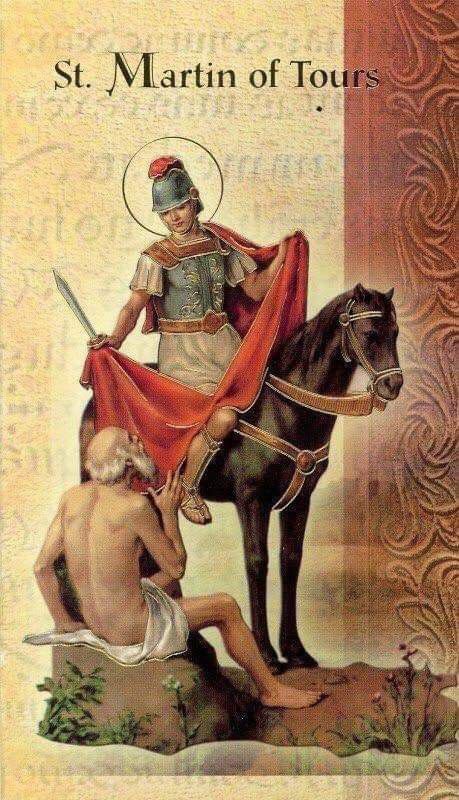Saint Martin's Day

(316 - 397)
Feast day: November 11
Sint Martin was actually called Martin of Tours. He was born in the Roman province of Pannonia (which is now largely in Hungary), near the monastery Szentmártonhegy (St Martinusberg) near today's Szombathely.
Martin's father was a Roman soldier and his mother was from Rome. Martin also became a soldier in the army of the Roman emperor. On a very cold winter day as he was riding home with a group of soldiers on his horse, Martin saw a poor man without a coat sitting in the snow. The man had no shoes on, he was very cold and begged for money to buy food. Martinus could not close his eyes to it, but he had no money for the man. He got off his horse and cut his own cloak in half with his sword and gave the poor man a half against the cold. Only then did Martinus continue his way home.
According to legend, the poor man was a symbol of Christ. At night, Christ himself would have appeared to Martin and said something like:
"I was naked and you clothed me."
Martin took the dream as a call and converted to Christianity. At the age of 18 he was subsequently baptized and after leaving the Roman army he became a student of Hilary of Tours, an important theologian and the Bishop of Poitiers. After this Martin, who was baptized by Hilarius, lived for some time as a hermit in Ligugé, a place near Poitiers, which after some time admitted him to the clergy. He also worked as an exorcist and traveled through Gaul to spread Christianity. Due to the large influx of followers, a monastery was founded near Poitiers in 361, the first in Gaul. Martinus lived here for twelve years.
Martin of Tours, who chose a life of frugality, was already well known during his lifetime. Where he went people flocked and many stories circulated of miracles that would have occurred after the intervention of the saint. One day, for example, after a long prayer from Martin, a young slave who had recently hanged himself would have come back to life.
Martin really made a name for himself when he miraculously won a discussion with pagans. He was incensed that some pagans worshiped a pine tree. Such idolatry was totally against his faith. Saint Martin ordered to cut down the tree. The heathen wanted to do it so that that tree would come down on the bishop. The pagans challenged him to remain standing. If 'his' Christ really existed, surely Saint Martin would be protected? The bishop accepted the challenge and lay chained under the tree. The tree fell and crushed not Saint Martin but the pagans.
November 11 is also the same distance from Christmas (six weeks) as Ash Wednesday from Easter. There have been regions where Advent originally lasted six weeks. Advent may have followed a pre-Christian custom of doing something with light in the darkness from early November until twelve weeks later (February 2, Candlemas). Going around with Saint Martin lanterns in various regions could indicate this.
There is also the custom to start carnival on this day. Possibly one thinks of the eleventh of the eleventh, the crazy number, but it could just as well be that this time in the bed of our solar year simply calls for an autumn carnival in which costume parties, going around with lanterns and feasting form a kind of summary of the harvest joy before the gets serious with the darkness and barrenness of winter. Perhaps the costumes of Halloween are not far from this.
He was soon canonized for his exemplary life and was highly regarded by the Frankish rulers at the time. When these Franks conquered our Low Countries and also took possession of the former Roman castellum in Utrecht on the current Domplein, they built a small church there. When the Anglo-Saxon missionary Saint Willibrord came to the Low Countries in the seventh century to Christianize them, he settled in this old castellum; the beginning of the Utrecht church.
In short, Martinus had made it. He was loved for demonstrating his true connection with God through his miracles and revered for being the first Northern European cleric to demonstrate this. But as was the case in the early Middle Ages, such popularity was not really rewarded until after one's death. Then came the canonization.
On November 8 in the year 397, Saint Martin died in Candes-Saint-Martin, France. On November 11, 397, he was buried in the Basilica and Abbey of Saint Martin of Tours, Tours, France.
Patron Saint of: Poor, Soldiers and France